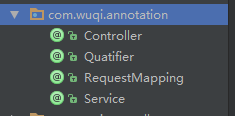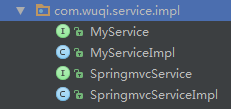手写注解实现SpringMVC底层原理
鄙人小白一个,还没毕业,就个人而言,搞IT这块,讲究思路。若对此文疑虑,评论来战。(本人->无期)
1.首先我们来搭建架构,就建一个普通的javaweb项目就OK了,具体目录如下:

对于小白来说可以细看后面web.xml的配置,对javaweb有点研究可以忽略而过后面的web.xml配置。
2.先上代码,运行起整个项目。再来聊聊思路。

(1).Controller注解

package com.wuqi.annotation; import java.lang.annotation.*; /** * Created by wuqi on 2017/3/22. */ @Target({ElementType.TYPE}) @Retention(RetentionPolicy.RUNTIME) @Documented public @interface Controller { String value() default ""; }
(2).Quatifier注解

package com.wuqi.annotation; import java.lang.annotation.*; /** * Created by wuqi on 2017/3/25. */ @Target({ ElementType.FIELD }) // 代表注解的注解 @Retention(RetentionPolicy.RUNTIME) @Documented public @interface Quatifier { String value() default ""; }
(3).RequestMapping注解

package com.wuqi.annotation; import java.lang.annotation.Documented; import java.lang.annotation.ElementType; import java.lang.annotation.Retention; import java.lang.annotation.RetentionPolicy; import java.lang.annotation.Target; /** * Created by Shock on 2017/3/22. */ @Target({ ElementType.METHOD }) // 在方法上的注解 @Retention(RetentionPolicy.RUNTIME) @Documented public @interface RequestMapping { String value() default ""; }
(4).Service注解

package com.wuqi.annotation; import java.lang.annotation.Documented; import java.lang.annotation.ElementType; import java.lang.annotation.Retention; import java.lang.annotation.RetentionPolicy; import java.lang.annotation.Target; /** * Created by Shock on 2017/3/22. */ @Target({ ElementType.TYPE }) @Retention(RetentionPolicy.RUNTIME) @Documented public @interface Service { String value() default ""; }
--------------------------------------------------------------------------------------------------------------------------

(1).MyService接口

package com.wuqi.service.impl; import java.util.Map; /** * Created by wuqi on 2017/3/23. */ public interface MyService { int insert(Map map); int delete(Map map); int update(Map map); int select(Map map); }
(2).MyServiceImpl类

package com.wuqi.service.impl; import com.wuqi.annotation.Service; import java.util.Map; /** * Created by wuqi on 2017/3/23. */ @Service("MyServiceImpl") public class MyServiceImpl implements MyService { @Override public int insert(Map map) { System.out.println("MyServiceImpl:" + "insert"); return 0; } @Override public int delete(Map map) { System.out.println("MyServiceImpl:" + "delete"); return 0; } @Override public int update(Map map) { System.out.println("MyServiceImpl:" + "update"); return 0; } @Override public int select(Map map) { System.out.println("MyServiceImpl:" + "select"); return 0; } }
(3).SpringmvcService接口

package com.wuqi.service.impl; import java.util.Map; /** * Created by wuqi on 2017/3/23. */ public interface SpringmvcService { int insert(Map map); int delete(Map map); int update(Map map); int select(Map map); }
(4).MyServiceImpl类

package com.wuqi.service.impl; import com.wuqi.annotation.Service; import java.util.Map; /** * Created by wuqi on 2017/3/23. */ @Service("SpringmvcServiceImpl") public class SpringmvcServiceImpl implements SpringmvcService{ @Override public int insert(Map map) { System.out.println("SpringmvcServiceImpl:" + "insert"); return 0; } @Override public int delete(Map map) { System.out.println("SpringmvcServiceImpl:" + "delete"); return 0; } @Override public int update(Map map) { System.out.println("SpringmvcServiceImpl:" + "update"); return 0; } @Override public int select(Map map) { System.out.println("SpringmvcServiceImpl:" + "select"); return 0; } }
--------------------------------------------------------------------------------------------------------------------------

(1).SpringmvcController类

package com.wuqi.controller; import com.wuqi.annotation.*; import com.wuqi.service.impl.MyService; import com.wuqi.service.impl.SpringmvcService; import javax.servlet.http.HttpServletRequest; import javax.servlet.http.HttpServletResponse; /** * Created by wuqi on 2017/3/23. */ @Controller("wuqi") public class SpringmvcController { @Quatifier("MyServiceImpl") MyService myService; @Quatifier("SpringmvcServiceImpl") SpringmvcService smService; @RequestMapping("insert") public String insert(HttpServletRequest request, HttpServletResponse response, String param) { myService.insert(null); smService.insert(null); return null; } @RequestMapping("delete") public String delete(HttpServletRequest request, HttpServletResponse response, String param) { myService.delete(null); smService.delete(null); return null; } @RequestMapping("update") public String update(HttpServletRequest request, HttpServletResponse response, String param) { myService.update(null); smService.update(null); return null; } @RequestMapping("select") public String select(HttpServletRequest request, HttpServletResponse response, String param) { myService.select(null); smService.select(null); return null; } }
--------------------------------------------------------------------------------------------------------------------------

(1).DispatcherServlet类继承 javax.servlet.http.HttpServlet类

package com.wuqi.servlet; import com.wuqi.annotation.*; import com.wuqi.controller.SpringmvcController; import java.io.File; import java.io.IOException; import java.lang.reflect.Field; import java.lang.reflect.InvocationTargetException; import java.lang.reflect.Method; import java.net.URL; import java.util.ArrayList; import java.util.HashMap; import java.util.List; import java.util.Map; import javax.servlet.ServletConfig; import javax.servlet.ServletException; import javax.servlet.http.HttpServlet; import javax.servlet.http.HttpServletRequest; import javax.servlet.http.HttpServletResponse; /** * Created by Shock on 2017/3/23. */ public class DispatcherServlet extends HttpServlet{ private static final long serialVersionUID = 1L; List<String> packageNames = new ArrayList<String>(); // 所有类的实例,key是注解的value,value是所有类的实例 Map<String, Object> instanceMap = new HashMap<String, Object>(); Map<String, Object> handerMap = new HashMap<String, Object>(); public DispatcherServlet() { super(); } public void init(ServletConfig config) throws ServletException { // 包扫描,获取包中的文件 scanPackage("com.wuqi"); try { filterAndInstance(); } catch (Exception e) { e.printStackTrace(); } // 建立映射关系 handerMap(); // 实现注入 ioc(); } private void filterAndInstance() throws Exception { if (packageNames.size() <= 0) { return; } for (String className : packageNames) { Class<?> cName = Class.forName(className.replace(".class", "").trim()); if (cName.isAnnotationPresent(Controller.class)) { Object instance = cName.newInstance(); Controller controller = (Controller) cName.getAnnotation(Controller.class); String key = controller.value(); instanceMap.put(key, instance); } else if (cName.isAnnotationPresent(Service.class)) { Object instance = cName.newInstance(); Service service = (Service) cName.getAnnotation(Service.class); String key = service.value(); instanceMap.put(key, instance); } else { continue; } } } private void ioc() { if (instanceMap.isEmpty()) return; for (Map.Entry<String, Object> entry : instanceMap.entrySet()) { // 拿到里面的所有属性 Field fields[] = entry.getValue().getClass().getDeclaredFields(); for (Field field : fields) { field.setAccessible(true);// 可访问私有属性 if (field.isAnnotationPresent(Quatifier.class)); Quatifier quatifier = field.getAnnotation(Quatifier.class); String value = quatifier.value(); field.setAccessible(true); try { field.set(entry.getValue(), instanceMap.get(value)); } catch (IllegalArgumentException e) { e.printStackTrace(); } catch (IllegalAccessException e) { e.printStackTrace(); } } } SpringmvcController wuqi = (SpringmvcController) instanceMap.get("wuqi"); System.out.print(wuqi); } /** * 扫描包下的所有文件 * * @param Package */ private void scanPackage(String Package) { URL url = this.getClass().getClassLoader().getResource("/" + replaceTo(Package));// 将所有的.转义获取对应的路径 String pathFile = url.getFile(); File file = new File(pathFile); String fileList[] = file.list(); for (String path : fileList) { File eachFile = new File(pathFile + path); if (eachFile.isDirectory()) { scanPackage(Package + "." + eachFile.getName()); } else { packageNames.add(Package + "." + eachFile.getName()); } } } /** * 建立映射关系 */ private void handerMap() { if (instanceMap.size() <= 0) return; for (Map.Entry<String, Object> entry : instanceMap.entrySet()) { if (entry.getValue().getClass().isAnnotationPresent(Controller.class)) { Controller controller = (Controller) entry.getValue().getClass().getAnnotation(Controller.class); String ctvalue = controller.value(); Method[] methods = entry.getValue().getClass().getMethods(); for (Method method : methods) { if (method.isAnnotationPresent(RequestMapping.class)) { RequestMapping rm = (RequestMapping) method.getAnnotation(RequestMapping.class); String rmvalue = rm.value(); handerMap.put("/" + ctvalue + "/" + rmvalue, method); } else { continue; } } } else { continue; } } } private String replaceTo(String path) { return path.replaceAll("\.", "/"); } @Override protected void doGet(HttpServletRequest req, HttpServletResponse resp) throws ServletException, IOException { this.doPost(req, resp); } @Override protected void doPost(HttpServletRequest req, HttpServletResponse resp) throws ServletException, IOException { String url = req.getRequestURI(); String context = req.getContextPath(); String path = url.replace(context, ""); Method method = (Method) handerMap.get(path); SpringmvcController controller = (SpringmvcController) instanceMap.get(path.split("/")[1]); try { method.invoke(controller, new Object[] { req, resp, null }); } catch (IllegalAccessException e) { e.printStackTrace(); } catch (IllegalArgumentException e) { e.printStackTrace(); } catch (InvocationTargetException e) { e.printStackTrace(); } } }
所有的代码已经贴上,还有个web.xml

<?xml version="1.0" encoding="UTF-8"?> <web-app xmlns="http://java.sun.com/xml/ns/javaee" xmlns:xsi="http://www.w3.org/2001/XMLSchema-instance" xsi:schemaLocation="http://java.sun.com/xml/ns/javaee http://java.sun.com/xml/ns/javaee/web-app_3_1.xsd" version="3.1"> <servlet> <servlet-name>testServlet</servlet-name> <servlet-class>com.wuqi.servlet.DispatcherServlet</servlet-class> </servlet> <!-- ... --> <servlet-mapping> <servlet-name>testServlet</servlet-name> <url-pattern>/*</url-pattern> </servlet-mapping> </web-app>
3.好了代码已经贴上了,现在需要来说说思路,因为有代码了,所以用代码来将思路,这样更容易理解代码的含义。之后可以根据自己的程度去试着写。
- 首先我们需要扫描包中的所有文件(DispatcherServlet -> init(ServletConfig config) -> scanPackage("com.wuqi")),也就是含有注解的文件。然后将该包下的所有文件都存入packageNames集合中。
- 这时我们拿到了包下所有的文件,但我们只需要含有我们指定注解的那部分文件,因此需要过滤出我们想要的文件即可,并且在过滤的过程中,我们可以将过滤出来的类通过Class.forName来直接实例化并储存起来。存放到instanceMap集合中,并为其设置对应的key值,该key值就是类注解的value。
- 然后遍历instanceMap集合中的所有对象,获取指定注解的对象,并通过反射获取该对象的所有的方法,遍历所有的方法,将指定注解的方法存入handerMap,key为拼接字符串("/" + 对象变量名 + "/" + 方法名),value为方法(Method)。
- 然后我们可以遍历instanceMap集合中的所有对象,通过反射获取对象的所有属性值(字段)集合,然后遍历属性值集合,将属性值含有指定注解的,通过Field的set方法为该属性值赋值,这时就将对象注入了。(也就是往Controller中注入Service对象)
- 最后就可以通过反射的invoke方法调用某个对象的某个方法。(此时对象存于instanceMap,而方法都存于handerMap)
借鉴 -> http://blog.csdn.net/chaoyueygw/article/details/53393952该博文
